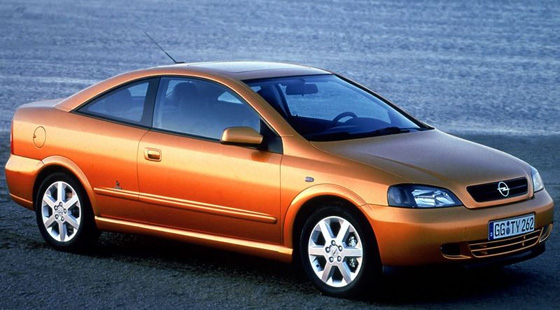 Cars with a coupe body type have always been part of the Opel production program. It is enough to mention, for example, models such as the GT, Manta – or the last one in this series – calibrate. Opel coupes were characterized by aggressive styling, very good performance and traction properties. At the same time, they always used the latest technical and technological solutions, np. brakes with increased efficiency, supercharged engines, all-wheel drive. Opel coupes have never been spartan equipped, and the relationship between the quality of their workmanship and the price made other manufacturers complex. Following this tradition, spring 2000 General Motors launched the Astra II Coupe for sale.
Cars with a coupe body type have always been part of the Opel production program. It is enough to mention, for example, models such as the GT, Manta – or the last one in this series – calibrate. Opel coupes were characterized by aggressive styling, very good performance and traction properties. At the same time, they always used the latest technical and technological solutions, np. brakes with increased efficiency, supercharged engines, all-wheel drive. Opel coupes have never been spartan equipped, and the relationship between the quality of their workmanship and the price made other manufacturers complex. Following this tradition, spring 2000 General Motors launched the Astra II Coupe for sale.
The body design and production of the car were entrusted to specialists from Bertone, located near Turin. Just like the previous coupe – calibrate – The Astra Coupe is one of the series production cars with the lowest drag coefficient Cw = 0,27. For good traction, meeting the expectations of a sports car, designers focused on two aspects of high body rigidity. First, it is about the torsional rigidity of the body, which is important when driving a vehicle at high speeds. The exterior of the Coupe achieves the result 18000 Nm / 1 degree, which exceeds the values achieved by the sedan, recognized as the leader among cars of this class available on the market. Secondly, the rigid cage of the passenger compartment and the crumple zones of the front and rear part of the car guarantee an adequate level of passive safety.. When designing the safe body of the car, solutions proven in the Astra model were used, np. the pedals falling off their attachment in the event of a frontal impact, beam roof reinforcements and double stringers.
The vehicle took over the suspension from the Astra II model, which have been modified, to ensure high stability and good handling when driving at high speeds. For this purpose, the deflection force of the front McPherson z 21 do 24 Nm/mm. More rigid shock absorbers and stabilizers were also used. These measures have radically reduced body tilt in corners and also ensure that the wheels are kept perpendicular to the road surface in tight, fast corners.. Driving precision was achieved, using electro-hydraulic power steering. The pressure pump only starts up, when the force required to turn the steering wheel exceeds the value, set by designers. In practice, the assistance works at full speed in terms of speed 0-65 km/h. After that, the pump is turned off and activated when the steering wheel is moved quickly or when making a deep turn.
The value of a sports coupe is determined by the vehicle's engine and driveline. Three engines from the ECOTEC family were used to power the Astra. The smallest with a capacity 1,8 dm3 is known from Vectra and allows to achieve 100 km/h po 9,9 seconds, and its advantage is low fuel consumption. But more is expected from a sports car. The other two engines can meet these requirements. Outstanding drivers will love the 2.0-liter turbocharged engine with charge air cooling. Z 2 dm3 of capacity it reaches 140 kW of power at 5400 rpm and has maximum torque, amounting to 250 Nm in the range 1950-5300 rpm. Speed 100 km / h the car with this engine reaches after 7,2 seconds. Astra Coupe with ECO-TEC family engine. It is having a mass 138 kg, All-aluminum 4-cylinder engine 2,2 dm3. Two balance shafts are used to reduce vibrations in the crank-piston system, and the new shape of the combustion chambers allowed to optimize the combustion process and ensure compliance with the Euro toxicity standards 4. Despite loading the exhaust system with two catalysts and exhaust gas recirculation into the cylinder, the engine uses a moderate amount of fuel (minimal, repeatable, unit consumption obtained during the tests was 240 g / kW / h), offers a very high torque of 203 Nm at 4000 rpm and power 108 kW at 5800 rpm. By constructing this engine, its durability was taken care of and service activities were reduced to a minimum. Therefore, among others. a chain with a hydraulic tensioner is used to drive the camshafts, which does not require replacement. Periodic adjustments and inspections are also not performed in the timing system – adequate valve clearance is maintained automatically by a system of hydraulic valve lifters. Another assembly that does not require maintenance is the ignition system. The engine uses coils mounted directly on plugs with platinum electrodes. In this way, unreliable and moisture-sensitive high-voltage cables are eliminated. The service life of spark plug electrodes during pre-production tests was determined as 100 thousand. km mileage. So, engine service is just about changing the oil, filters and tension control of V-belts, which also have an extended service life.
The Astra Coupe is a fun car to drive. Its excellent performance is combined with very high driving comfort, excellent road stability, constant, close to neutral, driving characteristics, effective brakes and fuel consumption on the level of a typical C-segment car with an engine power of approx. 70 kW.
Opel Astra II Coupe
